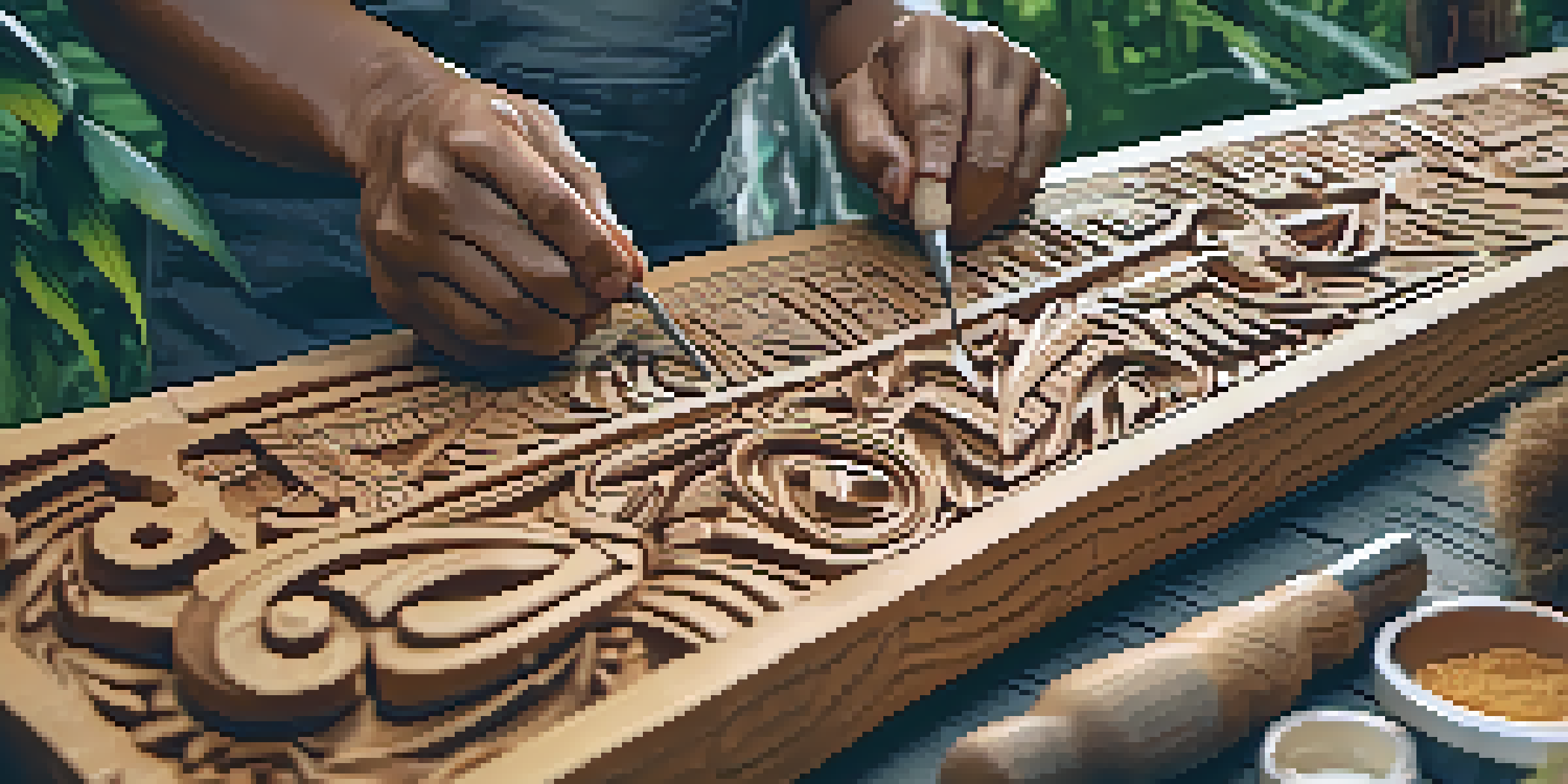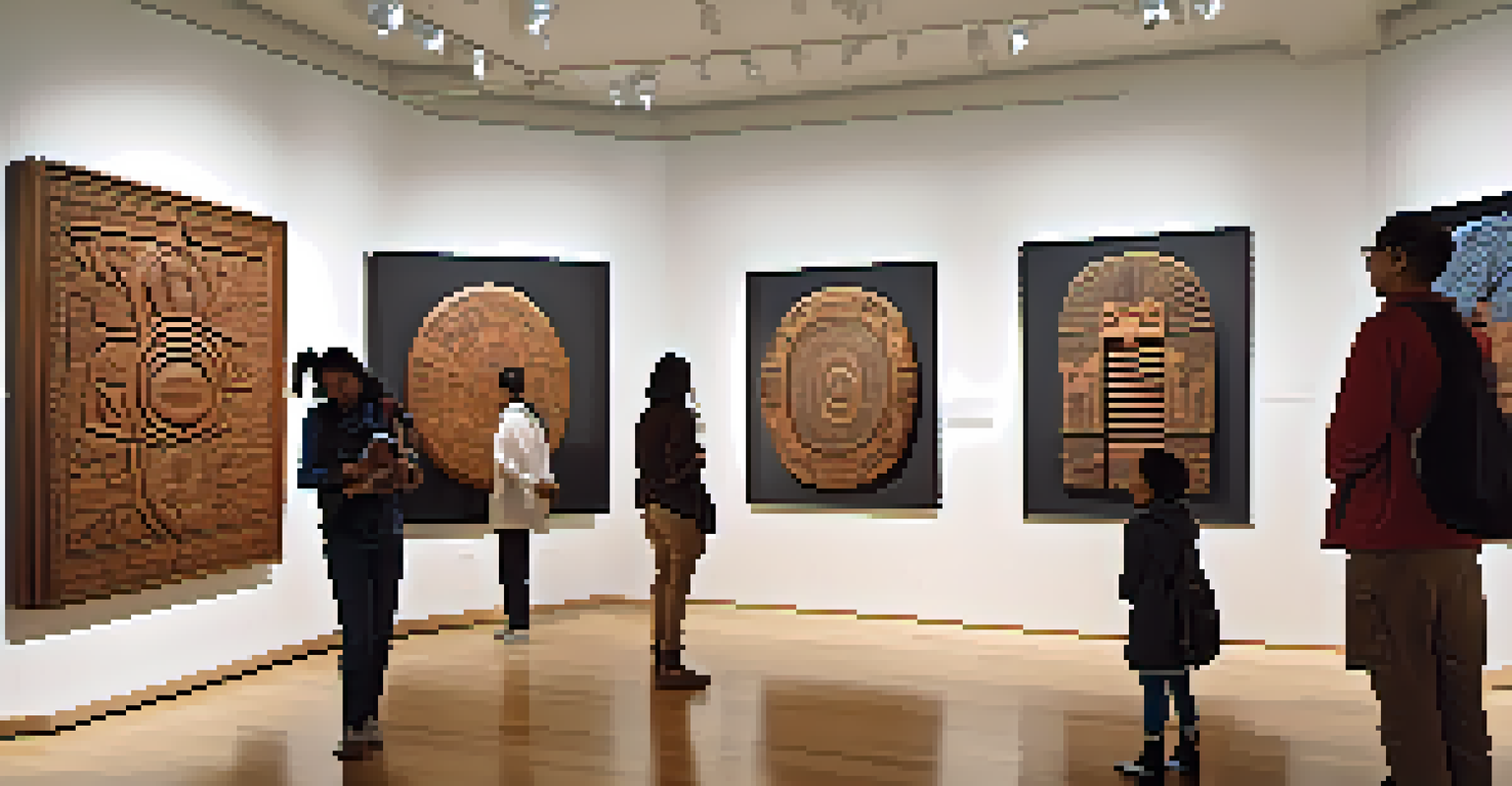The Impact of Colonialism on Indigenous Carving Traditions

Understanding Indigenous Carving Traditions
Indigenous carving traditions are rich, diverse practices that reflect the culture, spirituality, and history of various communities. These art forms often use natural materials, such as wood and stone, and are deeply embedded in the storytelling of the people. Carving serves not just an artistic purpose but also a functional one, often being used in ceremonies or as tools in daily life.
Art is not a mirror held up to reality, but a hammer with which to shape it.
For many indigenous groups, carving is a way to connect with ancestors and the natural world. Each piece tells a story, whether it’s a totem pole representing lineage or a ceremonial mask used in rituals. The craftsmanship and techniques are often passed down through generations, making it a living tradition that evolves yet retains its core identity.
However, these traditions are not static; they have been influenced by various factors over time, including colonialism. Understanding the impact of colonialism on these practices requires a closer look at the historical context and how indigenous communities have navigated change.
Colonialism's Disruption of Traditions
Colonialism introduced significant disruptions to indigenous cultures, including their carving traditions. As colonizers imposed their beliefs and practices, many indigenous artists faced pressure to abandon their traditional methods. This often resulted in the loss of knowledge, as elders were marginalized or even silenced, disrupting the transmission of skills essential for carving.

Additionally, the demand for indigenous art from colonizers often led to the commercialization of these traditions. While this brought some recognition, it also diluted the cultural significance of the works. Carvings that once held deep spiritual meaning were sometimes produced merely for tourist consumption, altering their original purpose and context.
Carving as Cultural Identity
Indigenous carving traditions serve as a vital expression of cultural identity, connecting communities to their ancestors and histories.
The impact of colonialism was not uniform; various communities experienced it differently based on their location and the nature of the colonial presence. Some groups were more resilient, adapting their practices to preserve their identity amidst external pressures.
Resistance Through Carving: A Form of Cultural Survival
Despite the challenges posed by colonialism, many indigenous artists have used carving as a form of resistance. By continuing to create traditional pieces, they assert their cultural identity and challenge colonial narratives. This act of carving becomes a statement of survival, resilience, and pride in one’s heritage.
The function of art is to do more than tell it like it is; it’s to imagine what is possible.
Many contemporary indigenous artists draw on traditional techniques while also incorporating modern influences. This blending of styles not only revitalizes carvings but also creates a dialogue between the past and present. It allows artists to express their unique experiences while honoring their ancestors.
Thus, carving has evolved into a powerful medium for storytelling and cultural expression, reflecting both the struggles and triumphs of indigenous communities. This artistic resistance plays a crucial role in maintaining cultural identity in a post-colonial world.
The Role of Education in Reviving Carving Traditions
Education plays a pivotal role in the revival of indigenous carving traditions. Community workshops and cultural programs have emerged, focusing on teaching younger generations the skills and significance behind traditional carving. This not only helps to preserve techniques but also fosters a sense of pride in cultural heritage.
In many cases, indigenous artists are taking the lead in these educational initiatives. By sharing their knowledge, they empower youth to connect with their roots and understand the importance of their cultural practices. This generational transfer of skills helps ensure that carving traditions are not lost to history.
Impact of Colonialism
Colonialism has disrupted indigenous carving traditions, leading to the loss of knowledge and the commercialization of spiritual art forms.
Moreover, educational programs often emphasize the historical context of colonialism, allowing students to critically engage with their heritage. This understanding of the past enriches their carving practice, making it not just about art but also about reclaiming identity.
Modern Challenges Facing Indigenous Carvers
While there has been a resurgence in interest in indigenous carving, modern challenges persist. Issues such as appropriation, where non-indigenous artists replicate traditional designs without proper understanding or respect, continue to plague the community. This not only undermines the authenticity of the art but also disrespects the cultural significance behind it.
Furthermore, environmental changes and resource depletion affect the availability of materials traditionally used in carving. Indigenous communities often rely on specific types of wood or stone, and as these resources become scarce, it poses a threat to their traditional practices. This challenge requires innovative solutions that respect both culture and sustainability.
Despite these obstacles, many indigenous carvers are finding ways to adapt. By advocating for their rights and using social media platforms, they are raising awareness about their traditions and the importance of ethical practices in art.
Celebrating Indigenous Carving in Contemporary Art
The contemporary art world has begun to celebrate indigenous carving traditions, recognizing their value and significance. Galleries and museums are increasingly showcasing indigenous artists, providing a platform for their work to reach broader audiences. This recognition not only elevates the artists but also educates the public about the intricacies of indigenous cultures.
Exhibitions often feature carvings that merge traditional techniques with contemporary themes, illustrating the dynamic nature of this art form. This blend allows for a richer narrative, where traditional stories meet modern experiences, creating a dialogue that resonates with diverse audiences.
Education Revives Traditions
Community-led educational initiatives empower younger generations to learn traditional carving skills, fostering pride and cultural continuity.
By celebrating these traditions, the art world plays a crucial role in fostering respect and understanding. It helps combat stereotypes and encourages appreciation for the depth and complexity of indigenous cultures and their carving practices.
The Future of Indigenous Carving Traditions
Looking ahead, the future of indigenous carving traditions appears promising yet challenging. As more indigenous artists gain recognition, there is potential for these traditions to flourish in new ways. However, the preservation of authentic practices amidst commercialization will require careful navigation and support from both communities and the art world.
Collaboration between indigenous artists and collectors can foster a more respectful and ethical approach to the art market. By prioritizing direct relationships and fair compensation, the value of the art can be better appreciated, ensuring that the cultural significance remains intact.

Ultimately, the resilience of indigenous carving traditions lies in the hands of the artists and their communities. By continuing to tell their stories through their art, they can ensure that these traditions not only survive but thrive for future generations.